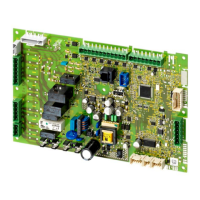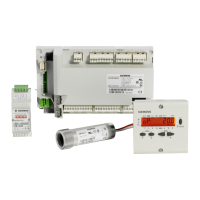407/617
Building Technologies Division User Manual LMS14… CC1U7471en
6 The settings in detail 28.01.2015
None
Input with no function.
Optg mode changeover
Heating circuit:
The operating modes of the heating circuits are switched to Protection mode via
input Hx (e.g. using a remote telephone switch) (Optg mode changeover
(900/1200/1500))
DHW:
DHW heating is locked only when using setting HCs + DHW or DHW.
Heat generation lock
The heat source is locked via terminals Hx. All requests for heat from the heating
circuits and from DHW are ignored. Frost protection for the boiler is maintained.
Note!
The Chimney sweep function can be activated although heat generation lock is
active.
Error/alarm message
Input H1 generates a controller-internal error message. If the Alarm output (Relay
output QX2 (5891), Relay output QX3 (5892), Relay output QX4 (5894)) is
appropriately configured, the error message is forwarded or displayed by an additional
contact (e.g. an external lamp or horn).
Consumer request VKx
The adjusted flow temperature setpoint is activated via the terminals (e.g. air heater
function for a warm air curtain).
Note!
The setpoint is to be set via Flow temp setp cons request (1859/1909).
Release swi pool heat source Q19
This function enables swimming pool heating to be released by the heat source.
Note!
The setpoint is to be set via Flow temp setpoint (1959).
Excess heat discharge
Active dissipation of excess heat enables an external heat source to force consumers
(heating circuit, DHW storage tank, Hx pump) to draw excess heat by delivering a
forced signal. Parameter Excess heat draw (e.g. (861) for heating circuit 1) can be used
to determine for every consumer whether or not it shall take account of the forced
signal and, hence, whether or not it shall draw heat.
Local effect:
When using LPB device address 0 or >1, excess heat discharge only acts on the
local consumers connected to the controller.
Central effect (LPB):
When using LPB device address = 1, excess heat discharge also acts on the
consumers connected to the other controllers in the same segment. The
distribution of excess heat from segment 0 across other segments of the system is
not possible.

